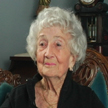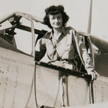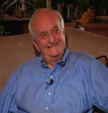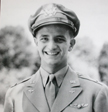| "LETTERS TO DEFIANCE" |
 
CLICK ON PHOTOS
FOR A SNEAK PEEK

|
FRANCIS SEIBERT was born in the small town of Defiance Ohio. During The War, his orders kept him in Amarillo, Texas as an instructor on the instrument systems of the B-17 and B-29.
He worried that his letters home might be considered too boring, so, to spice them up, he started drawing cartoons that incorporated the family address. His mother saved all 614 of these wonderfully illustrated envelopes! The envelopes show his humorous side while the letters inside reveal a young man with an amazing insight into a time and an era that asked so much of the whole country.
This documentary takes the 83-year-old Francis back to the letters as he reads them for the first time in over 60 years, including his first Christmas away from home, his Mother's Day letter, hearing about the D-Day invasion and the dropping of the first atomic bomb. |
 |
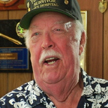 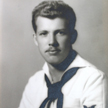
CLICK ON PHOTOS
FOR A SNEAK PEEK
(1:15)
|
JACK HAMMETT was stationed at Pearl Harbor when the Japanese attacked. Without a thought for himself, he made his way towards the fighting, commandeering a local cab to get him to the Naval Hospital as quickly as possible. He watched helplessly as other cabs carrying other sailers, also on their way to the base, were straffed by the Japanese planes. Once at the base, Jack was immediatley confronted with the job of deciding who might live and who should be made comfortable as they died. He spent the next three days working in the hospital with minimal breaks. He was only 19-years-old.
The men at Pearl Harbor were not only dealing with the death and destruction of the December 7th attack, there were also rumors running rampant that the Japanese had landed on the island and were attacking and killing the townspeople. Jack worried about his wife, but it wasn't until 72 hours after he had gotten onto the base that he was finally able to get a few hours leave to go home and check on her.
Jack continued fighting in the war - helping to run the hospital that handled the casualties from the landing at D-Day, fighting in North Africa and in the Atlantic on Anti-submarine action.
He is also the founder of The Freedom Committee of Orange County
|
| go to top of page |
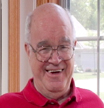 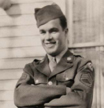
CLICK ON PHOTOS
FOR A SNEAK PEEK
(1:15)
|
ROGER SEIBERT was drafted into the army at 18 and soon sent over to England as part of the 387th Anti-Aircraft Battalion. Part of the army that liberated Paris, his unit marched in... and then kept on marching - and fighting - as they ran the Nazies out of France.
His Battalion were attached to the 5th Armored Division which were the first Americans to fight on German soil in this War - sent in at Wallendorf to draw the German troops away from the actual target of Aachen.
He made it through the war without a scratch, only to break his nose in a jeep accident after Germany had already surrendered. |
| |
 
CLICK ON PHOTOS
FOR A SNEAK PEEK
(1:15)
|
FRANCIS LUCCA joined the Navy a month after his 18th birthday. He was assigned as the radio operator on the Destroyer Escort Burrows.
In the Mediterranean he was able to save the fleet of ships under their escort from German U-boats waiting in ambush. With great concentration, Fran was able to hear the allies warning code despite the jamming signals sent by the enemy.
Mr. Lucca missed the first Atlantic crossing on the "Leaky B" due to Scarlett Fever, but made it through the next 14 crossings, as well as 8 months in the Pacific. Their escort armada covered nearly 150,000 miles without losing a single ship under their watch. A near record for any WW II fighting ship.
|
| |
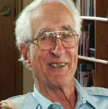 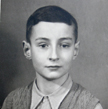
CLICK ON PHOTOS
FOR A SNEAK PEEK
(2:10)
|
JURGEN HERBST was only 11 years old when the war broke out in his native Germany. His father, a veteran of the First World War, again served in the army, despite his dislike of the Nazis.
Along with many of the boys his age, Jurgen was told he must join the Jungvolk and at the age of thirteen became a leader in his hometown of Wolfenbüttel, Germany.
After seeing the ravages of Kristalnacht in his hometown, Jurgen began to sense that something was wrong with the Nazi Party, and thus began a slow process of moral awakening that led him to question his loyalty to the Nazi regime. At the young age of only sixteen he was sent to the Western front to fight the allies.
One of only ten German youths chosen to visit the United States after the War, Jurgen was then given a scholarship to the University of Nebraska where, following in his father’s footsteps, he continued his education to become a “Scholar”. Jurgen has taught for over 30 years at colleges all over the United States. |
| |
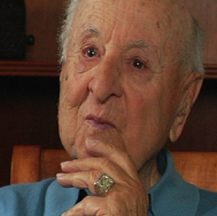 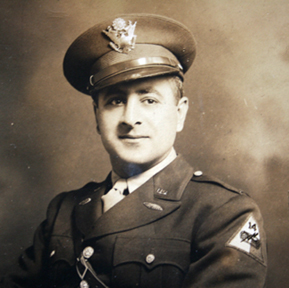
CLICK ON PHOTOS
FOR A SNEAK PEEK
(2:20)
|
LT. COLONEL DAN FELLER is 100 years old. He had his introduction to war on D+2 when he landed at Utah Beach as part of the 24th Armored Reconnaissance Battalion of the 7th Army Corps. Their mission was to seek out and report enemy posistions. At 32 he felt it was his duty to look after the "young men" of his battalion, and even though he was an Officer he would eat and sleep with his men.
After several months of battle, his battalion was given orders to move to the rear for a some much needed R & R. On their way to the back they received an urgent message to return to the front... the Battle of the Bulge had begun. The battalion was part of the fierce house-to-house fighting that occurred in the battle at Aachen - The first major German City to fall to the Allies.
After the war he was discharged from the army only to be recalled 4 1/2 years later for duty in the Korean War where he was assigned to the 8th Cavalry of the 1st Cavalry Division. |
| go to top of page |
 
CLICK ON PHOTOS
FOR A SNEAK PEEK
(1:00)
|
BENNY RAMOS was the radio operator on a B-17 and flew over 35 missions... crashing only 3 times! He tells of close calls and saving lives in their flights over enemy territory.
His is also a story of how
life still continues, despite the pain and fear that surrounds them: A buddy in his barracks made the mistake of showing Benny a photo of the young woman who was writing to him - Benny took the photo and said, "This is the woman I am going to marry!" And four years later, soon after the war ended, he did just that! The two live happily in Buffalo, NY - celebrating over 60 years of marriage! |
| |
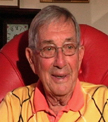 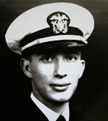
CLICK ON PHOTOS
FOR A SNEAK PEEK
(1:00)
|
MORTON STOVROFF was one of the few men stationed on a submarine during the war. There were only 484 subs and 52 of them (and 3,506 men) never came back. That made his chances of being sunk, 1 in 9! - And this was a position he had volunteered for. This small amount of submarines were responsible for sinking over 30 percent of the Japanese navy, including 8 aircraft carriers. Their fight left the Japanese economy in shambles by sinking almost 5 million tons of shipping. |
| |
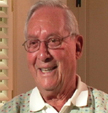 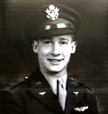
CLICK ON PHOTOS
FOR A SNEAK PEEK
(1:00)
|
IRWIN STOVROFF was as a Bombardier on the B-24, "The Passion Pit". He was on his last (35th) mission, bags packed for home back at the barracks, when their plane was shot down just on the other side of the Channel.
Quickly captured by the Germans he was taken for interrogation to the Dulag Luft. There he was shocked to find the interrogator knew things about his home town and family that Irwin had never told him. When asked how he knew all these things, the German informed Irwin that he had been his paperboy back in Buffalo, NY! He had lived just around the corner from the Stovroff family.
Mr. Stovroff just recently received The Legion of Honor from the French Government for his bombing missions that helped liberate France during the War. |
| |
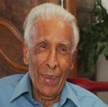 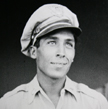
|
MIGUEL ENCINIAS fought in three wars and ran missions over East Germany during the Cold War. Part Apache and part Hispanic, he was awarded a Purple Heart in WW II and then received another Purple Heart in the Korean War.
During WW II, as a Fighter Pilot flying the Spitfire, he was a leading the four pilots who were able to avert disaster and save many American lives at Anzio beach in Italy. They came upon 30 enemy bombers heading for the allies who were stuck on the beach. Miguel was able to shoot down two bombers, his comrades shot down four more. It evidently scared the German commanding officer enough to make the bombers dump the rest of their bombs and retreat.
Shot down in February of 1944, he spent the next 14 months as a POW at Stalag Luft 1 in Barth, Germany.
In 1994 Miguel was asked by the White House to serve on the Advisory Committee for the World War II Memorial. He was the only WW II veteran on the Committee for the entire seven years until its opening. |
| go to top of page |
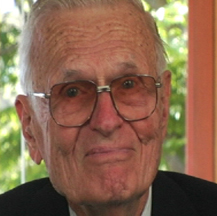 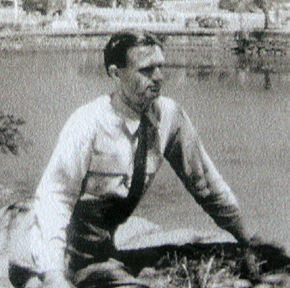
|
DR. LENNOX TIERNEY is 99 and is the last living member of General Douglas MacArthur's GHQ team during the post-war occupation of Japan. The Navy had sent him to a secret training program where he spent 17 hours a day, 7 days a week learning Japanese for the planned invasion of Japan.
In post-war Japan he was chosen to head up the Arts and Monuments commission. One of his first jobs was to remove the old propaganda from the Japanese school books. He was also in charge of finding out what monuments and artworks were where, if they needed repair and when and how they would be restored.
Gen. MacArthur would bring Tierney along whenever he thought he might need someone knowlegeable on Japanes culture, including MacArthur's encounter with the Emporer of Japan. The account that Dr. Tierney gives of that discussion is something that, he says, "you will never read in the history books." |
| |
 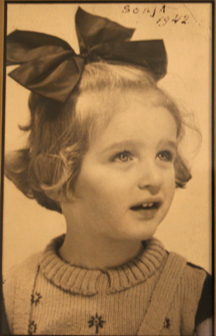
|
SONJA TELIAS was only 3 years old when the German's invaded her native country of Holland. Being Jewish her family knew that it was very important to hide. Her parents gave her over to a woman she had never known before and this selfless woman hid her in her house for the next 3 years - keeping Sonja safe from the Nazis, knowing that if they were caught, she would also be imprisoned.
During those three years, Sonja could not go outside, and when she was in the house she could not stand up during the day for fear that someone might see her through the window. Her parents were able to secretly visit her on a few occasions, but otherwise the occupation years were spent without them. When the Nazis came in to inspect the home, the woman would hide Sonja in a hole in the wall behind a dresser. Sonja and her parents survived the Nazi invasion, but the rest of her family; aunts, uncles and cousins, perished in the concentration camps. |
| |
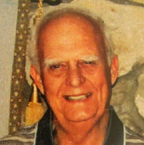 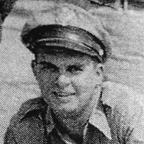
|
CAPT. WES COSS (Ret.) was the pilot on the B-17 "Stardust" that was stationed out of North Africa with the 15th Air Corps, 99th Bomber Group, 347th Squadron. They had flown nearly 30 sorties over Italy and France when his bomber was shot down by two FW-190’s and two ME-109’s in January of '44. Capt. Coss was able to escape capture and contact the French Resistance. The Maquis even took him on a hair-raising raid to steal food stamps from right under the Gestapo’s nose before secreting him up in the hills with three of his crewman, who had also escaped the Germans. The French Resistance hid them in three different houses - in plain sight of the Germans - for nearly a month. On the last leg of their journey through France, two of the crew members were captured by the German SS and their French Underground guides were executed. While the SS continued their search for Capt. Coss and his bombardier, S/Sgt. Joe Kinane, the local Resistance was able to move them on to their final leg - the attempt to walk over the Pyrenees Mountains into Spain. Once in Spain, the British were able to help them get to England. |
| |
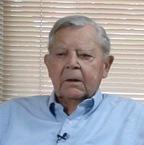 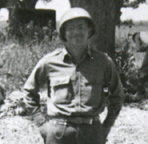
|
COL. CHARLEY RIGHTER joined the army in 1938 and was in the horse-drawn field artillery. During WWII he was in the 7th Army, 36th Regiment, 13th Artillery Brigade. As Captain of a “Long Tom” - 155mm artillery gun that could shoot 20 miles with deadly accuracy - he and his brigade participated in 3 landings (North Africa, Anzio and Southern France) and 8 major battles and received a Bronze star.
Capt. Righter would also fly reconnaissance missions for his Regiment. He flew a Piper Cub through enemy fire in Africa and then again over Rome, Italy. For the landing at the South of France the Army actually made one of the LST’s (Landing Ship, Tank) into their own little aircraft carrier for the Piper Cubs, but Capt. Righter’s most important job that day was to keep the landing area safe by shooting his gun's 95 pound projectiles at the enemy on shore. His regiment fought under Patton in North Africa, Sicily and again in Germany. |
| |
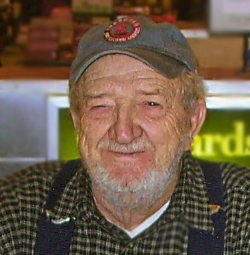 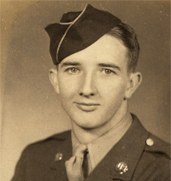
This interview was
filmed for us
By MR. THRASHER'S DAUGHTER AND SON-IN-LAW
|
ROBERT THRASHER was a member of the 99th Division's 395th Infantry Regiment, 3rd Platoon, Company L, and fought in the Battle of the Bulge. He was an infantry scout, serving as point man for his 40-man platoon. That meant he was the first of his platoon to enter enemy territory, which also made him the first target for enemy snipers and the one who would possibly be the first to discover land mines the hard way.
His Regiment helped to liberate POW and concentration camps and he recalls one encounter with General Patton, where, having gotten "cooties" from the camp survivors, the platoon had been standing for hours in the freezing rain waiting to be de-loused. Patton was speeding through camp in his jeep, splashing freezing slush everywhere. As he neared Thrasher’s Regiment the entire company simultaneously turned their backs. Patton stopped his jeep, backed up and gave them a tongue lashing for their "lack of respect".
Thrasher was awarded a Bronze star, Presidential Unit Citation, a Belgian Fourragere and other citations for his service. |
| go to top of page |
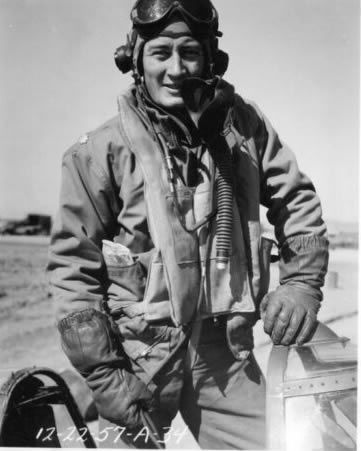 |
BRIGADIER GENERAL MICHAEL C. McCARTHY joined the US Air Corps shortly after Pearl Harbor was attacked. He became part of the 57th Fighter Group in North Africa where they were assigned to fight in the extremely dangerous air-to-ground battle for Sicily and Italy. First flying the P-40 Warhawk and then the P-47 Thunderbolt, the 57th valiantly battled through the German's deadly anti-aircraft fire so as to successfuly strafe and destroy the enemy's provisions and supply routes. Major McCarthy and his Fighter Group were a key part of the Allied successes in North Africa, Italy and Southern France. |
| |
RICHARD MOON was only 22 when he fought in the battle at Guadalcanal. A Marine who fought in the Pacific Theater under General MacArthur during WWII, Mr. Moon also participated in the battle for the Marshall Islands and Iwo Jima. |
| |
LT. HERB ALLEN was on the Destroyer USS Isherwood which was the first vessel attacked using Japanese Kamikazes. It was badly damaged from the assault and Mr. Allen was among those transferred to the USS Pinkney, a hospital ship - where six days later he survived another Kamikazi hit and watched as the severely damaged Pinkney burned for hours. |
| |
LILI SCHIFF (née Mendrowski) was born in Brussels, Belgium in 1932. She was one of millions who was required to wear a yellow star after the Germans invaded in May of 1940. Her father was a silversmith and the Germans took all of his work. She and her sister were saved from the Gestapo by a very selfless family. Their brother was not as lucky. He was rounded up in Brussels and taken to Auschwitz where he was gassed immediately. |
 |
RICHARD SATHER was one of Hermann Göring's guards during the Nürnberg trials, and had personal contact with Göring during his final days. He knew the secret to how Göring got the poison for his suicide. |
| |
JACK GIBSON was a Tail Gunner in a B-29 whose main mission was flying from India over Burma and China - called "The Hump" - to bomb strategic targets in Japan. On one such run they were shot down and all but one bailed out. Mr. Gibson was picked up from the ocean and interned for 6 months in a large Japanese POW camp located in Singapore. Because their last bombing raid had taken out a major supply depot and thus infuriated the Japanese, he and his crew were denied POW status - instead they were declared "Prisoners of the Emperor" which opened them up to torture and extremely poor treatment. Just before he and the remaining prisoners were to be executed the Japanese surrendered and the war ended. |
| go to top of page |
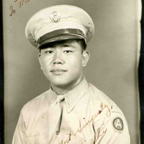

7/11/22 -
10/19/07 |
HIROSHI TAKUSAGAWA grew up in Santa Barbara, California. When the War broke out, his family was told to report to an internment camp. However, when Hiro heard that the 442nd, an all Asian infantry group, was forming, he didn't hesitate - he became one of the first to volunteer for military service from a relocation center.
The 442nd, whose battle cry was "Go For Broke," fought at Anzio beach and were among the first Americans to free Rome. They also fought in the dangerous and nearly impenetrable Vosges Forest of France near the German border. Hiro felt that his mission was to show that they could fight and die just like any other American. His musings at the end of the war: "People tend to try and find something romantic about war. It's horrible. And that's an understatement." After a long pause he added, "A huge understatement." |
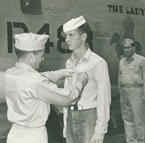

9/16/25 -
12/28/85 |
PATRICK M. HIGGINS, USNR joined the Officer Flight Program of the Navy at the age of 17. Worried he would miss the war, Pat volunteered for active duty as a bow gunner on a B-24 "Liberator". In April of 1945 the Army Air Corps had been high altitude bombing a Floating Dry Dock for months with no success. On April 29 th they decided to try a coordinated attack with the Army doing their usual high altitude attack followed closely by two Navy Bombers at wave top level. Pat’s pilot, Lt. Stuart, volunteered for the mission. They had to zig zag to avoid hitting the Japanese ships. Stuart kept saying "Don't shoot Higgy, they're looking up!" The Japanese were still shooting up at the Army while the Navy Gunners held their fire until they dropped their bombs and then let them have it with every gun blazing.
Pat flew forty (40) combat missions from Iwo Jima until the Atom Bomb ended the war and he was Honorably Discharged.
This Navy photo was taken at an Airfield on Iwo Jima in 1945. An Admiral is awarding a young Patrick Higgins the Air Medal for those "Meritorious Actions" performed during the wave level attack. |
BUFFALO, NY
WISH LIST |
From Sue Drabik: My father, George Brown has told his story many times. "My most vivid memory of WWII is the day I was on guard duty in Casablanca. It was the middle of December 1942, and we were stationed in a school yard. It was very hot and I became very sleepy, so I tilted my chair back, laid my submachine gun across my lap and soon fell asleep. Suddenly I hear a loud, "Soldier!" I recognized the voice of General Patton, who was headquartered nearby at the Gulf Oil Building a block away from where I was sleeping. Following a severe reprimand, he returned to his car and continued back to his headquarters. I thought no more about this until several years later when I attended an army reunion. Col. Waldschmidt asked several of the Veterans what incident most stood out in their memories of WWII. I explained my encounter with General Patton. He exclaimed, 'You were the one!' He proceeded to tell me how General Patton had called him that day and ordered him to have me Court Martialed and shot for sleeping on guard duty. When Col. Waldschmidt requested the name, rank and serial number of the soldier, General Patton said, 'I was so g**d**m mad, I forgot!' Inasmuch as the men assigned to guard duty were picked at random at this time, there was no record kept, so no one knew it was me. I am very happy to be here today to tell my story."
My father is very proud of the years he spent in the army as it was his first family. He was an orphan who was never adopted, and he believes he learned many of what everyone else says are his best assets from his experiences in the service. |
| From Raymond Paladino: My father Samuel Paladino, who is now 82-years-old, is a WWII Veteran. He was a member of "Merril's Marauders" who traveled through the jungle of Burma and India into China. My father, who is a slightly built man, made it through that harrowing experience and he is still living and making the most of his life. He still works every Friday cutting hair, still takes on a little Theater part in a play every year and sings with local talent groups for special events and shows. |
From Edward McCaffery: I have a distant relative, John Conable, who was a Major on General McArthur's staff and was ordered to take a small force into Japan after the agreement to surrender, but before the actual signing on the Missouri. He is a retired Judge in Wyoming County. As you can imagine, his being the first American to set foot on the Japanese mainland was a harrowing experience. Many of the top Japanese military officers were not in agreement with the surrender and threatened to continue to fight the war. |
| From Joyce: My dad, who is a WWII POW, has some amazing stories to tell, especially about when he was a prisoner. He saw one of the American prisoners was injured when he bailed out of his plane. My dad didn't know him, but he knew the Germans would shoot him if he couldn't march. My dad forced the man, who didn't want to go (he wanted to be left to die), into a little wagon that my dad found in one of the barns the Germans had the POWs in. My dad dragged that man around for weeks. Then war ended and they were liberated. That man knew my dad's name but never knew where he lived. He looked for 50 years to find my dad to thank him for saving his life only to find out he lived in his own back yard in the Buffalo area. My Dad was the flight engineer in a bomber for the 783 Squadron. |
From Beverly Aloisio-Marrs: My dad, who is 84 years old served in the War. He was injured and received the purple heart. He remembers everything about that war as if it were yesterday. He came to America from Italy when he was about 16. His Dad, my grandpa served in WWI so his children were naturalized citizens of the U.S. I have listened to many of my dad's accounts of the war and find it ironic that at one point he was asked to guard his own native Italian countrymen during the war, but knew that it was his duty because he was fighting for America.
I have taught my children to honor these men and women who fought for our freedom and I wish others would do the same. I am sad to think that in the next ten years they may all be gone and the true accounts of what transpired will be gone with them. |
From Donald Splitter: My Dad is a Veteran of WWII and he served in the Battle of the Bulge. He just attended his A/924 reunion. Only 9 guys were able to attend this year.
My Dad is 87 years old and he has the greates memory of anyone I know. |
| go to top of page |
| From Derek Smith: Two of my neighbors were Army Infantry and both were wounded in action. One gentleman was a Captain who fought in North Africa. He was shot in the leg, captured by the Germans and spent several years in an Italian POW camp. The other was a Private in the "Old Hickory" Division and saw much combat in the Battle of the Bulge, where he was also wounded (and also in the leg) |
| From A. Digregorio: I know a Veteran who was a B-24 Liberator Navigator and was shot down. His name is Gil Montazolli. |
| From D.Lyn Chambers: There's a friend of mine, named Terence S. Underwood, who served honorably as a young Major in the British Inidan Army during WWII in the Middle East. He became a citizen in 1958, and his writing is full of passion for a country he loves and wishes it to be the very best that it can. He can provide a unique insight into what was going on in the Middle East during the time he served. |
| From Angela Oliveri: My father-in-law was in the Navy, on the Ludlow and has stories he said he would like to share. His name is Marino Oliveri. |
Leonard Gaj wrote: As a Prisoner of War for approximately 1 year I kept a diary of my POW days. The pencil printing is beginning to fade. |
| From Margaret Deuschle: My father, 89, is a WWII Veteran and former POW. Although he does not freely discuss the war, he has recently spoken about a few events in POW camp and the war in general. As you well know, this generation does not brag about their war efforts and my father is no different. |
| From Betty Whitehead: My Dad was a POW in WWII and while a prisoner he kept a journal. I never knew about it before I found it. My Mom kept it put away, almost hidden, and I guess protected for over 60 years. Written with lead pencil and folded it was very hard to read because the lead smudged, there were cross outs, and some torn pages. So, with a magnifying glass and a bright lamp I decided to transcribe the whole journal word for word. My Dad was part of "The Red Ball Express" when he got overseas. He was quickly promoted to Sergeant after basic training because he spent many years in the National Guard. He and another soldier single handedly blew up a German tank. That's when he became a POW. There are letters to my Mom in the diary; stories about how they had to move from one Stalag to another and how he befriended German farmers just to get a potato; A story how he improvised a bellows type contraption and traded its use for cigarettes. I would love to share his stories with others. |
From Linda Covell: I was privileged to hear a program by an 84 year old WWII Veteran who was was a POW at Stalag 17 and was the longest held prisoner there. His story is amazing and his telling of it riveting. As an example of his ingenuity: to prevent the enemy from getting his flack jacket, he cut it in strips and wove it into a book cover, which he still has. |
| go to top of page |














